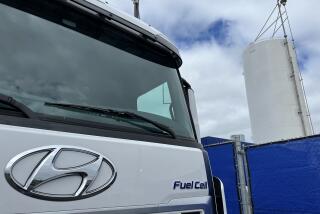Long-anticipated fuel cell unveiled
- Share via
After nine years of research shrouded in secrecy, a Silicon Valley tech firm Wednesday took the wraps off a fuel cell that it says can generate energy by combining air and a wide range of fuels without going through the process of combustion.
The firm, Bloom Energy, said the solid oxide fuel cell -- resembling a Polaroid snapshot both in dimension and thickness -- could be a game-changer in the clean technology industry because it can be powered by either fossil fuel or renewable sources in an electro-chemical process that is both cleaner and more reliable than current options.
In the company’s plans, thousands of fuel cells would be crammed into a box about the size of a refrigerator called the Bloom Energy Server, each capable of producing 100 kilowatts of electricity, or enough to power 100 average-size homes or a small office building, Bloom said.
Unlike solar and wind power, which can be intermittent, the technology can run all day, and customers can earn back the system’s $700,000 to $800,000 cost within a few years through utility bill savings, Sunnyvale, Calif.-based Bloom said.
Several major companies, including FedEx Corp., Google Inc., Staples Inc. and Wal-Mart Stores Inc., have already begun testing the technology or signed on as customers. The trial runs have so far produced more than 11 million kilowatt-hours of energy while cutting 14 million pounds of carbon dioxide emissions, Bloom said.
At the Coca-Cola Co.’s Odwalla plant in Dinuba, Calif., a 500-kilowatt fuel cell installation from Bloom is expected to use biogas to supply 30% of the facility’s power needs while reducing emissions by 35%.
Last year, EBay Inc. set up a 500-kilowatt system powered by biogas outside its San Jose headquarters, taking 15% of the campus’ energy needs off the electrical utility grid. The fuel cells, which EBay dubbed “skinny batteries,” were officially introduced at the company’s site Wednesday with Gov. Arnold Schwarzenegger and former U.S. Secretary of State Colin Powell on hand.
Bloom Chief Executive K.R. Sridhar, a former NASA scientist, described the technology behind the fuel cell in a statement as potentially having “the same kind of impact on energy that the mobile phone had on communications.”
Fuel cell technology has been in development for decades, with hydrogen as the usual fuel source. But Bloom’s flat ceramic squares are more versatile, the company said.
“There are probably another 100 companies that are working on something very similar,” said Jack Brouwer, associate director of the National Fuel Cell Research Center in Irvine. “But the key thing is that Bloom has an integrated system and package ready for commercial sale that puts them ahead of the pack.”
Bloom was founded in 2001 after Sridhar and his team conducted research for NASA’s Mars exploration program on using solar energy and water to produce air and fuel. The company raised $400 million from investors, including Kleiner Perkins Caufield & Byers and Morgan Stanley.
Brouwer said that for now the technology is probably better suited to powering entire neighborhoods rather than individual homes. And, while the individual cells seem to have a robust life span, the full system’s long-term reliability has yet to be proved, he said.
Still, “it’s one of the best ways to introduce more renewable power and support the grid, and it does so in a very environmentally sensitive way,” he said.
More to Read
Inside the business of entertainment
The Wide Shot brings you news, analysis and insights on everything from streaming wars to production — and what it all means for the future.
You may occasionally receive promotional content from the Los Angeles Times.










